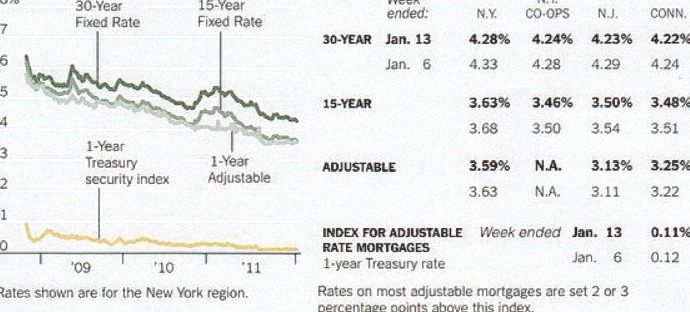A Reprieve for Unemployed Borrowers
For interest in Southern California luxury real estate in Los Angeles County, as well as coastal Orange County homes and San Diego homes, call Bob Cumming of Keystone Group Properties at 310-496-8122. Keystone Group Properties serves discriminating buyers and sellers of high-end La Jolla California real estate and properties from Newport Beach, Dana Point and Laguna Beach to Palos Verdes and Palos Verdes Estates, Mission Viejo, Redondo Beach, Santa Monica, and Malibu.We also present exclusive Los Angeles CA homes in Beverly Hills, Bel Air, and Beverly Glen California.
A Reprieve for Unemployed Borrowers
The New York Times
Fannie Mae and Freddie Mac recently extended their foreclosure forbearance programs to give short-term aid to unemployed homeowners, but housing counselors warn that these borrowers will need to look at longer-term solutions.
Making sense of the story
- In a forbearance program, a lender agrees not to foreclose on a property and gives the borrower several months’ grace from or reduction in monthly mortgage payments. The programs work best for temporary setbacks, like job loss, health problems, or natural disasters.
- There are drawbacks to the forbearances though. The most-significant drawback is a larger total debt from the smaller payments. The unpaid balance continues to increase during this time.
- The new temporary mortgage payment is often set to 31 percent of the household income; in some cases lenders agree to accept no payments. Fannie Mae’s extended unemployment program, first offered in the fall of 2010, limits any nonpayment or other forbearance plans to one year, with the second six months requiring approval by both Fannie Mae and the lender.
- However, even with the program in place, the lender could still report a mortgage as delinquent, which could adversely affect the borrower’s credit score.
- Because some agreements add onerous term and conditions, homeowners should also consult with a housing counselor certified by the Dept. of Housing and Urban Development.
- In a forbearance program, a lender agrees not to foreclose on a property and gives a borrower several months’ grace from or reduction in monthly mortgage payments. The programs work best for temporary setbacks, like job loss, health problems or natural disasters.
- Along with the reprieve come drawbacks — most significantly a larger total debt from the smaller payments. “Your unpaid balance keeps getting higher and higher and higher,” said Jennifer Murphy, the director of lender-servicer relations for the nonprofit Center for New York City Neighborhoods.
- The new temporary mortgage payment is often set to 31 percent of your household income; in some cases lenders agree to accept no payments. Fannie Mae’s extended unemployment program, first offered in the fall of 2010, limits any nonpayment or other forbearance plans to one year, with the second six months requiring its approval as well as the lender’s.
But even with the program in place, your lender could still report a mortgage as delinquent, which would adversely affect your credit, so ask about its policy, said Martha Cedeno-Ross, a foreclosure assistance counselor with Neighborhood Housing Services of Waterbury, Conn. Because some agreements may add onerous terms and conditions, homeowners should also consult with a real estate lawyer, or a housing counselor certified by the Department of Housing and Urban Some 26,801 homeowners completed Fannie Mae loan forbearance and repayment plans in the first nine months of 2011, up 13 percent from the same period in 2010. By comparison, the total for all of 2008 was 7,892, according to Fannie Mae’s financial filings with the Securities and Exchange Commission.
To qualify, borrowers must be unemployed, which means not working at all, though a co-borrower could still be employed, said Brad German, a Freddie Mac spokesman.
To get started, gather up your financial information and consider writing a “hardship letter,” an overview that clearly states what happened and when, Ms. Cedeno-Ross said. The letter could also serve as a starting point for a loan modification and other programs. Give details about your previous salary, severance payments and unemployment benefits; if you have had job interviews, include those details, she said.
You will need to fill out the four-page uniform borrower assistance form used by both Freddie and Fannie, Mr. German said. It is also good for government mortgage assistance programs like Making Home Affordable — http://www.makinghomeaffordable.gov — and Knowyouroptions.com.
Be sure to plan an “end strategy” well before the forbearance agreement runs out.
“The big question every homeowner should find out: Where will this forbearance lead me?” said Charles Das, a housing counselor for Brooklyn Housing and Family Services. Homeowners usually get a repayment plan or a loan modification, he said, but he has seen some denied the modification because of low income.
Ms. Murphy says homeowners should use the 6 to 12 months of reduced payments to work with a financial or housing counselor, and if possible, save money and pay off secured debts.
Sometimes borrowers may determine after counseling that they cannot afford the home, said John Walsh, the president of Total Mortgage Services of Milford, Conn. They may then need to sell the home or arrange for “a graceful exit” — for instance, agreeing to give up the deed in lieu of foreclosure, or pursuing a short sale, in which the lender agrees to accept less than the mortgage balance.
To get started, gather up your financial information and consider writing a “hardship letter,” an overview that clearly states what happened and when, Ms. Cedeno-Ross said. The letter could also serve as a starting point for a loan modification and other programs. Give details about your previous salary, severance payments and unemployment benefits; if you have had job interviews, include those details, she said.
You will need to fill out the four-page uniform borrower assistance form used by both Freddie and Fannie, Mr. German said. It is also good for government mortgage assistance programs like Making Home Affordable — http://www.makinghomeaffordable.gov — andKnowyouroptions.com.
Be sure to plan an “end strategy” well before the forbearance agreement runs out.
“The big question every homeowner should find out: Where will this forbearance lead me?” said Charles Das, a housing counselor for Brooklyn Housing and Family Services. Homeowners usually get a repayment plan or a loan modification, he said, but he has seen some denied the modification because of low income.
Ms. Murphy says homeowners should use the 6 to 12 months of reduced payments to work with a financial or housing counselor, and if possible, save money and pay off secured debts.
Sometimes borrowers may determine after counseling that they cannot afford the home, said John Walsh, the president of Total Mortgage Services of Milford, Conn. They may then need to sell the home or arrange for “a graceful exit” — for instance, agreeing to give up the deed in lieu of foreclosure, or pursuing a short sale, in which the lender agrees to accept less than the mortgage balance.
By VICKIE ELMER, The New York Times
Published: Monday, January 23, 2012
La Jolla CA Homes for Sale


